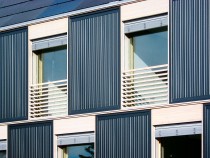
© Archiv Detail
“Kraftwerk B” (Power Station B), the architects’ name for the 7-apartment building, is next to St. Sebastian’s church in the middle of Bennau, a district of Einsiedeln in central Switzerland. Shortly after completion the new building became nationally known as a pilot project for solar self-sufficiency. According to the architects’ calculations it derives 10% more energy than its occupants need from the sun. And “Kraftwerk B” is one of the first Swiss buildings to meet the Swiss Minergie-P-Eco standard. As well as prescribing energy efficiency comparable with a passive building this standard also defines upper limits for resource use by building materials and minimum levels for interior climate, sound insulation, daylight use and other factors that are often not paid sufficient attention by a purely energy-based evaluation.
“Kraftwerk B” is a rental property whose architect Joseph Grab was his own client. Otherwise it would scarcely have been possible to realize the project in this form. All the technology in the building has stood the test of time, but the architects’ insistence on immaculate integration of solar thermal energy and photovoltaics into the building envelope meant a great deal of planning work.
The building consists of a solid, loadbearing reinforced concrete core with prefabricated roof and façade elements made of timber. The staircase and the basement are completely separate from the residential levels to reduce the heated floor area. Even the basement ceiling was executed in two layers with insulation between, to avoid thermal bridges.
“Kraftwerk B” is a rental property whose architect Joseph Grab was his own client. Otherwise it would scarcely have been possible to realize the project in this form. All the technology in the building has stood the test of time, but the architects’ insistence on immaculate integration of solar thermal energy and photovoltaics into the building envelope meant a great deal of planning work.
The building consists of a solid, loadbearing reinforced concrete core with prefabricated roof and façade elements made of timber. The staircase and the basement are completely separate from the residential levels to reduce the heated floor area. Even the basement ceiling was executed in two layers with insulation between, to avoid thermal bridges.











